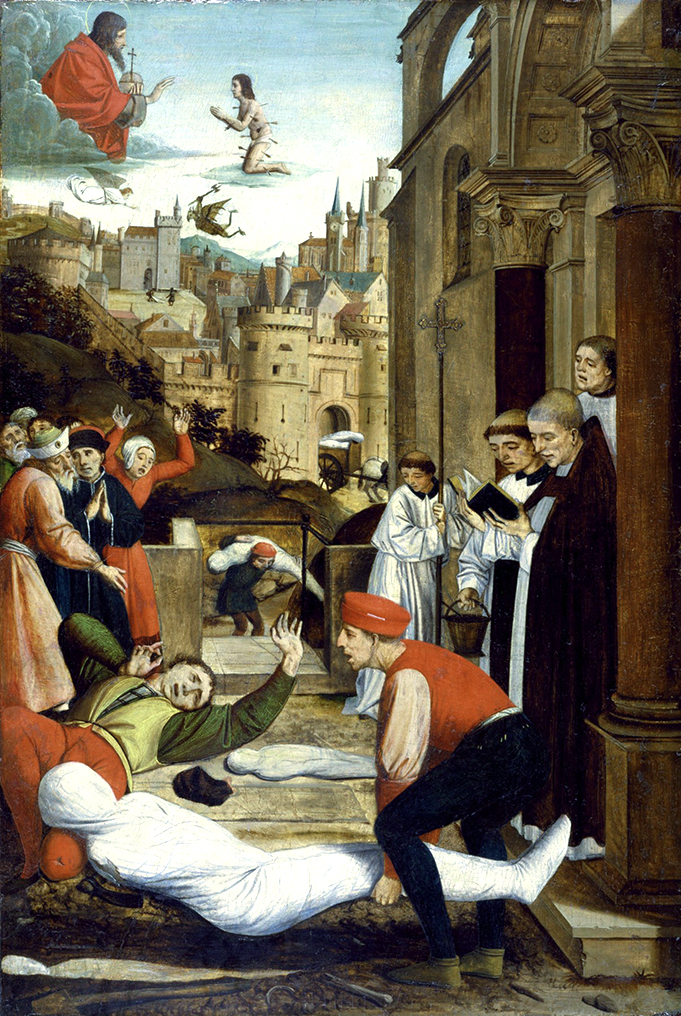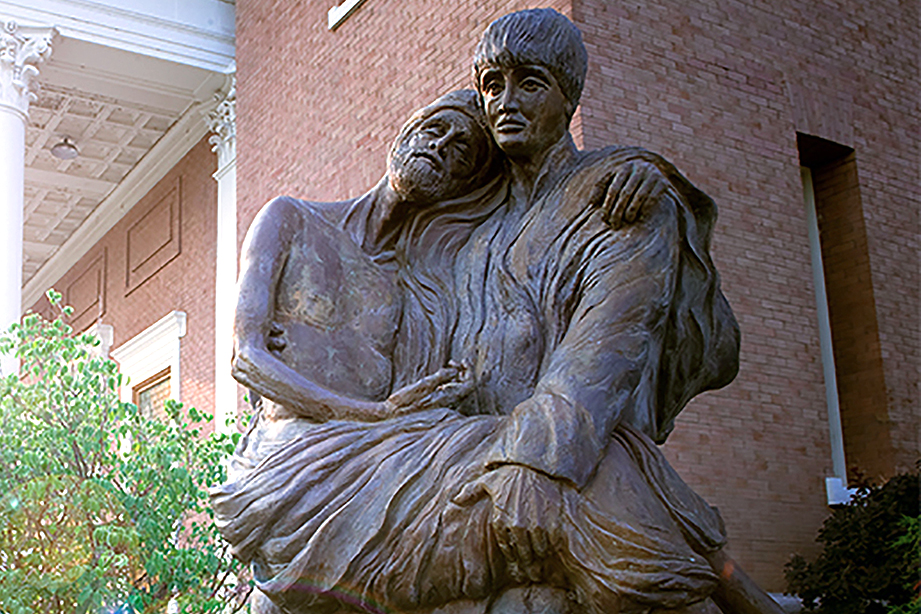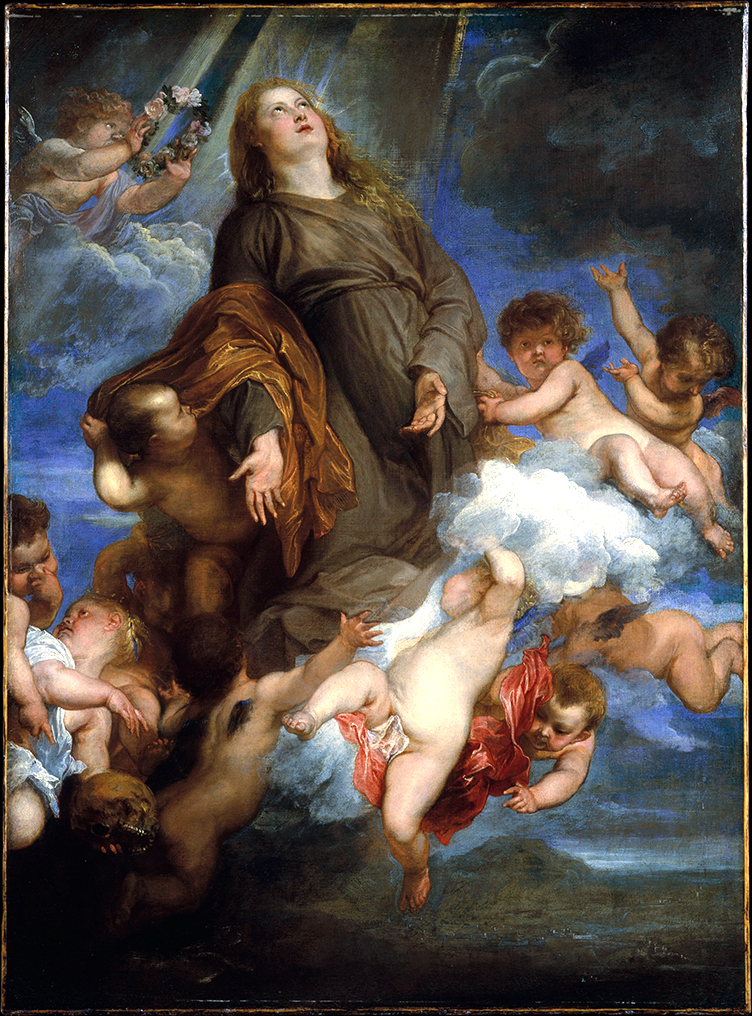
WASHINGTON (CNS) — The Catholic Church has had a long tradition of calling on saints and praying for their intercession in sickness and difficult times.
This plea for saintly help for protection from disease and healing was particularly evident when the bubonic plague, or Black Death, spread throughout Europe in the 14th century killing one-third of the population. At the time, in many cities and villages where medical knowledge was limited, cities and villages often adopted a plague saint to protect them.
The Catholic Church has numerous saints that are known for their ministry to the poor and outcast, the sick and dying, particularly during times of plagues, and a few particularly stand out now during this time of the COVID-19 global pandemic.
St. Sebastian

In Florence, Italy, the bishop had an altar built in honor of St. Sebastian as a means to stop the Black Death and after the plague was over, he built a church dedicated to the saint in thanksgiving for his intercession.
Artwork depicting the plague shows that St. Sebastian seemed to be the go-to saint at the time.
He was martyred around the year 288 during the reign of the Roman emperor Diocletian. He was shot by arrows, which is how he is portrayed in paintings where the arrows are also said to be symbolic of the arrows of the Black Death.
But the special appeal of St. Sebastian has a lot of layers. He is said to have converted to Christianity after seeing the bravery of Christian martyrs, and he then drew others to become Christian, including a Roman officer who was said to be have been cured of a plague at his conversion.
This particular action caught the attention of Diocletian, who sentenced St. Sebastian to death by arrows. But the saint, according to tradition, is said to have survived the arrows and returned to Diocletian to have strong words with him, which caused the emperor to again, and successfully this time, have St. Sebastian executed.
The saint’s prayers for the Roman soldier and the soldier’s cure made him associated with the cure of plagues, especially in Italy.
St. Roch
Topping most lists as a patron saint of plagues is St. Roch, who lived during the Black Death in the 14th century. He was said to have cured plague victims he visited in Italy with his prayers and by marking the sick with the sign of the cross.
Eventually, he too was sickened by the plague and is said to have withdrawn to a hut in the forest until he recovered. In paintings of the plague in which he is featured, he is shown among victims, often praying to Mary. Legend has it a dog brought him food, which is why statues of St. Roch often include a dog at his side.
Although the saint might seem far-removed from modern life, his care for plague victims certainly resonates today. In the U.S., there are several parishes named after him. One, in Oxford, Massachusetts, includes a prayer to the saint on its website asking the saint for “healing during this current health crisis during Lent and throughout the pandemic” and urging him to “intercede for the whole world.”
A section on the history of St. Roch describes him as someone who lived among the plague-stricken, and, because of this, “his thoughts went beyond the grave to that life after death, when there shall be no grief, nor sorrow, nor hunger, nor thirst, nor pain and when death shall be no more.”
It adds that St. Roch “saw in the plague-stricken an image of the Savior stricken for the sins of all.”

St. Aloysius Gonzaga
Another saint known for his care for plague victims, during a later plague in Rome in 1591, was St. Aloysius Gonzaga, who cared for plague victims in a Roman hospital while he was studying to be a Jesuit priest. He not only visited the sick but carried them to the hospital, washed their wounds and fed them. He ended up contracting the disease and died from it at age 23.
The saint’s example lives on today in particular at Gonzaga University in Spokane, Washington. The Jesuit-run school has a statue on campus of St. Aloysius carrying a plague victim.
On its website, the university describes the saint as a “model for servant leadership. Without a lot of fanfare and expectation of recognition or fame, Aloysius quietly and humbly cared for the abandoned, vulnerable and dying. He was clearly devoted to and at the service of others. He willingly gave up all claims to wealth and power in order to follow a call that he was convinced came from God.”
Gonzaga University, closed now during the coronavirus like other colleges and universities, also gave this shoutout to its namesake, saying: “Finding God in a beautiful sunset or the warm smile of a loved one is fairly easy. To discover God in festering wounds and disease is much harder. St. Aloysius Gonzaga, despite his youth, has taught us to search out God in those who need our help and care. He has taught us to look beyond the external and into the heart and spirit of our fellow humans, where we will find God’s love is alive in everyone.”
Amid the coronavirus pandemic, St. Michael’s — a Jesuit parish in Buffalo, New York — has a statue of St. Aloysius near its altar, placed there by the associate pastor, Jesuit Father Fred Betti, as a devotional aid in this time of anxiety about the pandemic.
The priest said St. Aloysius has always been invoked in times of epidemics, pointing out that in 1991, on the 400th anniversary of his death, St. John Paul II named St. Aloysius the patron of AIDS patients and AIDS caregivers.
He told The Buffalo News daily newspaper March 20 that the statue had been at the back of the Church, but he moved it to the front in mid-March because of the saint’s significance in this modern-day plague.
“He’s there temporarily for people to pray in this tough time,” the priest said, noting there are prayer cards near the statue with a prayer for the saint’s intercession that includes words the priest wrote saying: “May the Lord bring healing to the sick, wisdom to medical professionals, prudence to our civil leaders, charity toward all and hope to those who are discouraged.”
Although public Masses are suspended, the parish is open for private prayer, which respects social distances, each day.
“St. Michael’s being St. Michael’s, people come here from everywhere, including the homeless and the poor, so we are open from 7 a.m. to 5 p.m. during this time. And people are invited to come in and pray or spend time in reflection,” Fr. Betti told the newspaper.

St. Rosalia
Another saint at the top of lists for plague patrons is St. Rosalia, or Rosalie, who lived in the 12th century. The Church knows little about her life, but she plays a big part in prayers for healing from the plague, especially in the Sicilian city of Palermo in 1625 and even now.
During a plague in the city, the saint is said to have appeared to a hunter who found her remains in a cave. Her relics were paraded through the city streets and three days later the plague was gone, which people credited with her intercession and named her the city’s patroness.
As the coronavirus spread through Italy, many in Palermo during the government-imposed lockdown again turned to the saint, although with a more modern means: prayers on social media messaging platform WhatsApp.
St. Rosalie Parish in Hampton Bays, New York, describes its patron on the parish website. Like most every other parish website, it details new life amid the coronavirus pandemic with details about taped Masses but also on COVID-19 testing sites, an update on scam alerts and news about food pantry and senior assistance needs and availability.
In a letter to parishioners, the pastor, Fr. Steve Maddaloni, spoke about the parish’s financial struggle at this time and how the pandemic came right when he had prepared to make an appeal for increased donations.
“That was my plan. Then COVID-19 came along disrupting our lives, the financial markets, and employment for many. I decided that the time was not right to make that appeal. Now, like many other parishes, we face the problem of greatly reduced collections while our costs are not reduced,” he wrote.
The priest urged people not to give to the parish if they have lost work or cannot afford it and said parishioners with needs should contact the parish social ministry office.
He also ended with a message of hope, akin to the hope tied into the parish patron.
“These times are tough, but they won’t last forever,” he said. “This too shall pass. I thank you all for the many ways your generosity of time, talent and treasure make this parish what it is. Let’s continue to pray for each other and be thankful to God.”
Fourteen Holy Helpers
There also is a whole group of saints who were called on for prayers during the plague, starting in 1348 in Munich. This group goes by the name the Fourteen Holy Helpers.
The group of 14 — each with individual feast days and initially one day for the whole group until 1969 — is honored in a German chapel that is a pilgrimage site. There also are churches in Italy, Austria, Hungary and other European countries named after these 14 and one parish in West Seneca, New York, in the Diocese of Buffalo.
Twelve of this specialized group are martyrs and three are women. Perhaps most known now among the group is St. Blaise, patron saint of throats, who is invoked each Feb. 3 on his feast day, for blessing of the throats.
The names of the other 13 — and what people pray to them for protection from or intercession for — follow:
- St. Achatius, headaches;
- St. Barbara, fever or sudden death;
- St. Catherine of Alexandria, sudden death;
- St. Christopher, plagues, sudden death;
- St. Cyriacus (Cyriac), temptations;
- St. Denis (Dionysius), headaches;
- St. Erasmus (Elmo), abdominal maladies;
- St. Eustachius (Eustace), family trouble;
- St. George, protection of domestic animals;
- St. Giles (Aegidius), plagues, good Confession;
- St. Margaret of Antioch, safe childbirth;
- St. Pantaleone, physicians;
- St. Vitus (St. Guy), epilepsy.
Today, Fourteen Holy Helpers Parish in New York, looks, on its website, like most U.S. parishes. There are descriptions of usual activities and events in a nonpandemic time on the site, and at the top of the home page there is an announcement of online Masses, a plea for online giving to the parish and an urge to support local businesses. The full monthly calendar has the word canceled after every previously scheduled Church event.
“This period of time when we have been required to suspend public Masses and all parish events and services should certainly be considered one of the most difficult periods in the 156-year history of our parish. Even through this time of decreased activity, a number of expenses continue to be incurred … utilities, insurance, maintenance, and payrolls to name a few,” the parish announcement says.

St. Corona
During this current time of coronavirus pandemic, some have called on St. Corona as a possible patron, but the connection seems to be in name only. A Catholic News Service article about her said little is known about the young woman who was killed for her Christian faith, presumably in the second century A.D.
St. Corona also is not the namesake for the virus. The Latin word “corona” means “crown,” an indication that the young saint had achieved the “crown of eternal life” because of the steadfastness of her faith. The connection with the coronaviruses, named because of their crown-like structure, is just a coincidence.
Over the centuries, St. Corona was often prayed to by people seeking her help in times of trouble, be it heavy storms or livestock diseases.
People believed she had a positive influence regarding money matters since “coronae” (crowns) was the name given to coins. As a result, treasure-hunters often invoked her name, and, in light of how COVID-19 has triggered an economic crisis, she could be called on again.
In the listing of Church saints, there are at least 100 saints that can be invoked for protection or healing of nearly every possible ailment from eye troubles, headaches and toothaches to cancer, rabies and epilepsy.
— By Carol Zimmermann, Catholic News Service.






